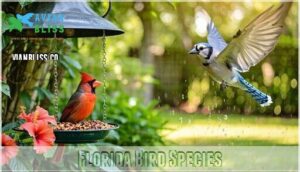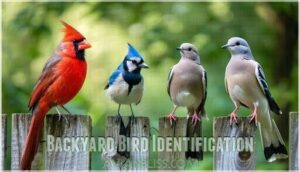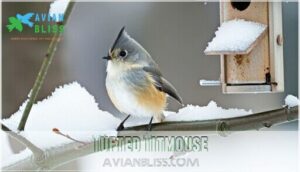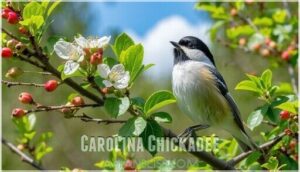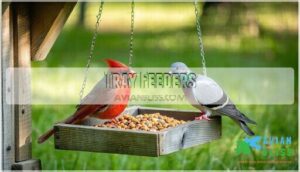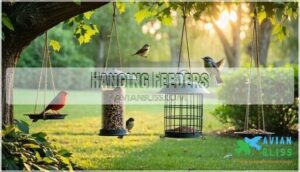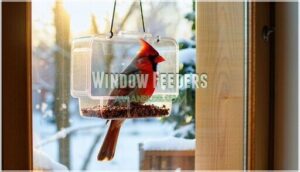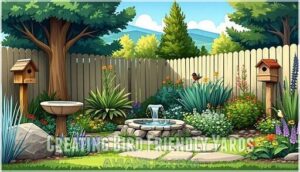This site is supported by our readers. We may earn a commission, at no cost to you, if you purchase through links.
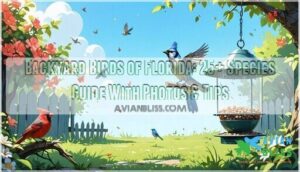 You’ll spot over 30 backyard birds of Florida year-round, transforming your outdoor space into a wildlife showcase.
You’ll spot over 30 backyard birds of Florida year-round, transforming your outdoor space into a wildlife showcase.
Northern Cardinals flash their brilliant red plumage while Blue Jays perform aerial acrobatics at your feeders. Tufted Titmice and Carolina Chickadees bring constant chatter and entertainment.
These feathered neighbors aren’t just pretty faces—they’re pest controllers, seed dispersers, and natural alarm systems rolled into colorful packages.
From tiny Downy Woodpeckers to majestic Red-shouldered Hawks, Florida’s backyard birds offer endless surprises. The secret lies in understanding what each species craves and where they prefer to dine, which is key to creating a natural alarm system.
Table Of Contents
- Key Takeaways
- Florida Bird Species
- Backyard Bird Identification
- Attracting Birds to Yards
- Bird Feeder Types
- Bird Food Preferences
- Creating Bird Friendly Yards
- Frequently Asked Questions (FAQs)
- What is the most common bird in Florida?
- How do I identify a bird in my backyard?
- What is the only bird found in Florida?
- What is the prettiest Florida bird?
- What time of year do most birds migrate through Florida?
- How do I identify male versus female backyard birds?
- What plants attract the most Florida backyard birds?
- Why do some birds visit feeders seasonally only?
- How often should I refill my bird feeders?
- Conclusion
Key Takeaways
- You’ll attract 30+ year-round and seasonal bird species by setting up diverse feeders with black sunflower seeds, mixed blends, suet, and fresh fruits to meet different dietary preferences.
- You can easily identify common Florida birds like Northern Cardinals (bright red males), Blue Jays (blue crests with white markings), Tufted Titmice (gray with black eye patches), and Carolina Chickadees (black caps with white cheeks).
- You’ll create an effective bird habitat by placing feeders 5-6 feet high near trees for escape routes, spacing them 10-15 feet apart, and cleaning them every 2 weeks to prevent disease.
- You’ll manage unwanted visitors by installing squirrel baffles, using weight-activated feeders, and positioning feeding stations at least 10 feet from cat hiding spots and 5 feet off the ground to maintain a healthy environment and support bird species.
Florida Bird Species
Florida’s diverse ecosystems support an impressive 539 recorded bird species, making it a premier destination for backyard birdwatching.
You’ll discover both year-round residents like the Northern Cardinal and seasonal visitors such as migrating warblers that transform your outdoor space into a dynamic wildlife theater.
Year-Round Residents
Florida’s year-round residents form the backbone of backyard birding adventures.
Northern Mockingbirds dominate every habitat, from urban neighborhoods to wild hammocks.
Northern Cardinals bring brilliant red flashes to suburban yards, while Carolina Wrens nest creatively in mailboxes.
Blue Jays adapt seamlessly across Florida’s diverse ecosystems.
The endemic Florida Scrub-Jay represents true Florida backyard birds exclusivity in Central Florida’s oak scrubs.
The Anhinga, also known as the snakebird or water turkey, is another common sight.
Seasonal Visitors
Beyond the year-round residents, Florida’s backyard birds include fascinating seasonal visitors that follow predictable migration patterns.
These winter visitors arrive as temperatures drop up north, while spring arrivals and fall travelers pass through during their journeys. Summer residents complete the seasonal cycle.
- Winter Visitors: Ruby-throated Hummingbirds, American Robins, and Painted Buntings seek Florida’s warmth from December through February
- Spring Arrivals: Palm Warblers and Blue-gray Gnatcatchers appear in backyards during March and April migrations
- Summer Residents: Greater Yellowlegs visit Florida backyards during warmer months before heading north
These migratory birds transform your backyard into a dynamic ecosystem throughout the year. Understanding the local bird species habits can help you attract and support a diverse range of birds.
Bird Characteristics
Identifying Florida bird species becomes easier when you understand key physical traits.
Beak shapes reveal feeding habits, while feather colors and wing patterns help distinguish similar species.
Bird sizes range dramatically across Florida’s backyard birds, from tiny hummingbirds to large woodpeckers.
| Characteristic | Identification Tips |
|---|---|
| Beak Shapes | Seed-crackers have thick, cone-shaped beaks; insect-eaters show thin, pointed bills |
| Feather Colors | Males typically display brighter plumage types during breeding season |
| Bird Sizes | Compare wingspan and body length to common references like robins or sparrows |
| Wing Patterns | Look for distinctive bars, spots, or solid color blocks during flight |
| Plumage Types | Note seasonal changes and differences between male and female birds |
Backyard Bird Identification
You’ll recognize these four common Florida backyard visitors by their distinct features and behaviors at your feeders.
Learning their key identifying marks helps you spot them quickly and understand what attracts each species to your yard.
Northern Cardinal
The Northern Cardinal stands out as Florida’s most recognizable backyard bird, with males sporting brilliant red feathers and females displaying warm reddish-brown tones.
These non-migratory Florida bird species maintain territories year-round, making them reliable companions for bird watching Florida enthusiasts.
Cardinals exhibit fascinating song patterns, with males whistling clear melodies from prominent perches.
Their nesting habits involve building cup-shaped homes in dense shrubs, while their feather care includes regular preening to maintain their striking appearance.
The Northern Cardinal’s distinctive characteristics and behaviors are influenced by its northern cardinal species profile, which plays a vital role in understanding its habitat and range and exhibits clear melodies.
Tufted Titmouse
These sprightly acrobats sport silver-gray plumage with light undersides and distinctive black patches above their beaks.
You’ll spot Tufted Titmouse flocks year-round in Florida’s oak and pine woodlands, where their social nature shines through constant chatter.
Their Nesting Behavior involves cavity selection in dead trees, while Feather Molting occurs post-breeding.
These backyard birds enthusiastically visit feeders for birdseed, making bird watching Florida adventures rewarding.
Carolina Chickadee
You’ll find Carolina Chickadees year-round in Florida’s woodlands and backyard bird habitats.
These tiny acrobats weigh less than half an ounce but pack enormous personality.
Their black caps and white cheeks make identification simple during your backyard birding adventures.
- Chickadee Habitat: Oak hammocks and pine forests where they cache thousands of seeds
- Chickadee Diet: Insects, seeds, and berries they remember storing months later
- Nesting Boxes: Cavities 4-8 feet high with 1⅛-inch entrance holes
- Feather Care: Daily preening keeps their insulation perfect for Florida’s temperature swings
Blue Jay
The Blue Jay stands out as one of Florida’s most recognizable backyard birds with its striking blue crest and bold personality.
These intelligent corvids bring excitement to any bird feeder setup, though they can dominate smaller species.
| Feature | Description |
|---|---|
| Size & Appearance | Large blue crest, vibrant blue and white feathers, distinctive black necklace marking |
| Blue Jay Habitat | Woodlands, parks, suburban yards throughout Florida |
| Jay Behavior | Aggressive at feeders, mimics hawk calls, stores acorns for winter |
| Nesting Patterns | Builds stick nests 10-25 feet high in tree forks |
| Flock Dynamics | Forms loose flocks, complex social hierarchy during Feather Care sessions |
Blue Jays prefer platform feeders with large perches for their size.
They’ll enthusiastically consume black sunflower seeds, mixed seeds, and peanuts while engaging in fascinating social behaviors that make them enchanting Florida bird species to observe.
Attracting Birds to Yards
Creating a bird-friendly backyard starts with understanding which types of feeders attract different Florida species.
You’ll want to combine seed feeders, platform feeders, ground feeders, and peanut feeders to maximize the variety of birds visiting your yard.
Seed Feeders
Seed feeders are your backyard’s bird magnets, drawing in cardinals, chickadees, and goldfinches with ease.
Choose tube feeders for smaller species or hopper designs for larger birds. Black sunflower seeds work best, though mixed birdseed attracts variety.
Clean feeders monthly to prevent disease. Position them near shrubs but away from windows.
Quality bird feeders florida residents recommend hold 2-4 pounds of seed, reducing refill frequency while keeping your backyard birds happy. Using the right tube bird feeders can substantially enhance the bird watching experience with the right tube feeders.
Platform Feeders
Platform feeders offer versatility that attracts diverse backyard birds like Sparrows, Blackbirds, Towhees, Juncos, Doves, Grackles, and Starlings.
These open-tray designs accommodate multiple species simultaneously, creating lively feeding stations. Proper feeder placement away from windows guarantees bird safety.
While platform designs with drainage holes prevent seed spoilage, regular feeder maintenance keeps your birdseed types fresh and your backyard birds healthy.
Ground Feeders
Many backyard birds prefer Ground Feeding over elevated feeders. Cardinals, Jays, Finches, and Sparrows naturally forage at ground level in your yard.
Strategic Feeder Placement enhances Bird Attraction while proper Yard Layout accommodates these Florida bird species.
Here’s how to set up effective Ground Feeders:
- Use platform-style feeders with drainage holes for Bird Seeds
- Place feeders 3-4 feet from shrubs for quick escape routes
- Choose mixed seed blends that attract multiple backyard birds
- Position away from high-traffic areas to reduce disturbance
Ground-level feeding mimics natural foraging behavior, making these bird feeder types incredibly effective for birdseed types distribution.
Peanut Feeders
For backyard birds in Florida, peanut feeders deliver high-energy nutrition that woodpeckers, chickadees, and nuthatches crave.
These specialized feeders come in various designs—from wire mesh styles to squirrel-resistant models.
Choose shelled or whole peanuts based on your target species’ preferences, and position feeders near trees for quick shelter access.
To maximize the effectiveness of peanut feeders, consider creating a bird friendly habitat that provides a thorough environment for the birds, and clean regularly to prevent spoilage in Florida’s humidity.
Bird Feeder Types
Choosing the right feeder type makes all the difference in attracting Florida’s diverse backyard birds to your yard.
Each feeder design serves specific bird species and their unique feeding behaviors, so you’ll want to match your setup to the birds you’re hoping to see, which is why choosing the right feeder is crucial.
Tube Feeders
With over a dozen tube designs available, these cylindrical feeders attract goldfinches, chickadees, woodpeckers, and nuthatches to your Florida backyard.
Smart feeder placement near shrubs provides escape routes while maintaining clear sightlines.
Choose quality black sunflower seeds for maximum bird attraction.
Regular feeder maintenance prevents mold and keeps your backyard birds healthy and returning consistently, using the right bird feeder types can enhance the overall bird-watching experience with the right feeder placement.
Tray Feeders
Tray feeders offer the most versatile bird feeder placement for attracting florida bird species to your backyard.
These open platforms accommodate various food types and allow multiple birds to feed simultaneously.
Tray Feeder Tips for ideal bird attraction:
- Tray Size matters – Choose 12-18 inch platforms to accommodate Cardinals and Blue Jays comfortably
- Mealworm Placement works best in shallow dishes within the tray for Eastern Bluebirds and American Robins
- Feeder Maintenance requires daily cleaning since open design collects debris and moisture quickly
- Bird Feeder Placement at 3-5 feet height provides easy access while maintaining safety from ground predators
Hanging Feeders
Versatility defines hanging feeders – they swing freely from branches, hooks, or poles while offering multiple Feeder Placement options.
These feeders excel at Bird Attraction through various Hanging Styles and Feeder Materials. Consider Weight Capacity when selecting hanging feeders for your backyard birds.
| Feeder Type | Best For |
|---|---|
| Tube Feeders | Cardinals, Chickadees, Goldfinches |
| Suet Cages | Woodpeckers, Nuthatches |
| Mesh Feeders | Finches, Pine Siskins |
Most bird feeders accommodate standard birdseed mixtures, making them perfect for attracting diverse Florida bird species.
Window Feeders
Window Mounts offer bird watching enthusiasts unparalleled intimacy with Florida bird species.
These glass-mounted bird feeders use suction cups for easy installation, bringing backyard birds mere inches from your view.
Here’s why window feeders transform your bird watching experience:
- Crystal-clear visibility – Watch Northern Cardinals crack seeds up close
- Safe glass types prevent bird collisions while maximizing transparency
- Versatile feeder designs accommodate different seed types and species
- Easy maintenance – clean both sides without ladder climbing
- Perfect for apartments – no yard required for quality bird watching
Window Mounts create magical moments when Carolina Chickadees peer back at you.
Bird Food Preferences
You’ll find success with backyard bird feeding by matching the right food to each species’ natural preferences.
Florida’s diverse bird population thrives on a mix of seeds, fruits, and protein sources that mirror their wild diet, which includes a variety of foods to support their health and well-being, and by providing the right food.
Mixed Seed Blends
Mixed seed blends work like a buffet for backyard birds, offering variety that attracts multiple species simultaneously.
These seed mixtures typically contain black oil sunflower seeds, white millet, and safflower—each appealing to different bird preferences. Cardinals love sunflower seeds, while ground-feeding doves prefer millet scattered below platform feeders.
Quality blends eliminate filler ingredients, ensuring wild birds get nutritious options. Proper feeder placement and regular bird feeder maintenance keep your seed types fresh and accessible.
By choosing the right bird seed mixes, you can create an inviting environment for various bird species to thrive in your backyard, with the right seed types and maintenance, making it a perfect spot for them.
Black Sunflower Seeds
Black sunflower seeds reign supreme as the gold standard for backyard birds in Florida.
These oil-rich powerhouses attract more bird species than any other seed type, making your feeder a bustling hotspot.
Here’s why Florida bird species can’t resist them:
- High fat content fuels Cardinals, Chickadees, and Woodpeckers through hot summers
- Easy-to-crack shells accommodate various beak sizes and feeding styles
- Year-round availability supports both resident species and seasonal migrants
Store seeds in airtight containers to prevent spoilage in Florida’s humidity.
Suet
Suet offers high energy nutrition that Florida’s woodpeckers, nuthatches, and chickadees crave.
These protein-packed cakes contain rendered fat mixed with seeds, nuts, and dried fruits.
Choose suet feeders with tail props for larger woodpeckers like Red-bellied Woodpeckers.
| Suet Types | Best For |
|---|---|
| Plain Suet | Basic nutrition, all suet-eating birds |
| Seed Mix Suet | Cardinals, finches, mixed species |
| Fruit Suet | Bluebirds, mockingbirds, wrens |
Winter suet placement works best in shaded areas to prevent melting.
Fresh Fruits
Fresh fruits attract Florida birds like American Robins and Northern Mockingbirds who can’t resist nature’s candy.
Plant native berry plants and citrus trees for year-round fruit selection.
Overripe bananas, apples, and oranges work perfectly for backyard birds.
Watch fruit ripening carefully – Florida birds prefer soft, sweet options over hard varieties for easier consumption, and they are particularly drawn to native berry plants.
Creating Bird Friendly Yards
You’ll transform your yard into a bird haven by choosing the right feeder locations and maintaining clean feeding stations.
Smart placement away from predators and regular maintenance will keep your feathered visitors healthy and coming back for more.
Ideal Feeder Locations
Strategic bird feeder location determines whether Florida’s backyard birds will visit your yard consistently.
Smart feeder placement brings Florida’s colorful birds straight to your backyard.
Place feeders where you’ll have clear viewing while giving birds the security they need to feed comfortably.
- Shaded Areas near large trees provide natural cover from predators and Florida’s intense sun
- Wind Protection from shrubs or structures keeps seeds from scattering and feeders stable
- Tree Proximity within 10-15 feet offers quick escape routes when hawks appear overhead
- Yard Layout with multiple sight lines lets you spot approaching cats or other threats
Feeder Placement Tips
Position feeders at eye level or slightly higher—around 5-6 feet—for ideal bird visibility and your viewing pleasure.
Space multiple feeders 10-15 feet apart to prevent territorial disputes among backyard birds.
Choose spots with morning sun exposure but afternoon shade to keep seeds fresh.
Consider your yard layout carefully; place platform feeders near natural perches like shrubs or trees where birds feel secure.
Cleaning Bird Feeders
Regular feeder sanitation keeps your backyard birds healthy and coming back for more. Clean feeders prevent disease outbreaks that can devastate local bird populations, making proper bird feeder maintenance essential for responsible birding.
Using a reliable bird feeder cleaner is vital for effective feeder cleaning tools.
Here’s your cleaning checklist:
- Disassemble feeders completely to reach every crevice where birdseed residue hides
- Soak in bleach solution (1:9 ratio) for ten minutes to eliminate harmful bacteria
- Scrub with stiff brushes to remove stubborn debris and mold buildup
- Rinse thoroughly with clean water to remove all disinfecting methods residue
- Air dry completely before refilling to prevent moisture-related contamination
Clean every two weeks minimum, or weekly during Florida’s humid summers when mold spreads faster than gossip at a church social.
Dealing With Squirrels and Cats
Squirrels and cats can turn your bird-friendly yard into a battleground.
Install squirrel baffles on poles and use weight-activated feeders that shut under heavier visitors.
For cat repellents, position feeders at least ten feet from hiding spots and five feet high.
These bird guards create wildlife safety zones where your feathered friends can dine peacefully in your florida bird conservation efforts.
Frequently Asked Questions (FAQs)
What is the most common bird in Florida?
With over 539 bird species recorded statewide, you’ll likely spot the Northern Cardinal most often in your Florida yard—those bright red males are unmistakable year-round residents.
How do I identify a bird in my backyard?
Start by observing key features: size, shape, colors, and markings.
Note the beak type, tail length, and wing patterns.
Watch behavior—does it hop, walk, or climb?
Listen to calls and songs.
Use field guides or bird identification apps to compare your observations with known species.
Use these tools to aid in your identification process.
What is the only bird found in Florida?
No single bird species is found exclusively in Florida.
You’ll find the Florida Scrub-Jay only in certain Florida scrublands, but it’s not the state’s sole resident.
Over 539 bird species call Florida home year-round or seasonally.
What is the prettiest Florida bird?
Like a living jewel catching sunlight, you’ll find the Painted Bunting reigns as Florida’s most stunning bird.
Males showcase brilliant blue heads, red underparts, and green backs—earning them the nickname "nonpareil," meaning without equal, as they are truly a bird "without equal".
What time of year do most birds migrate through Florida?
Most birds migrate through Florida during fall (September-November) and spring (March-May). You’ll see peak activity in October and April when warblers, raptors, and waterfowl pass through.
How do I identify male versus female backyard birds?
Look for size differences, color patterns, and behavioral cues.
Males typically display brighter plumage like red cardinals or blue jays, while females show muted browns and grays for camouflage during nesting.
What plants attract the most Florida backyard birds?
Plant native berry-producing species like elderberry, beautyberry, and firethorn.
You’ll attract cardinals, mockingbirds, and cedar waxwings.
Add sunflowers and coneflowers for seed-eating finches and chickadees.
Native fruit trees create natural feeding stations year-round.
Why do some birds visit feeders seasonally only?
Migration patterns drive seasonal feeder visits.
You’ll notice species like Palm Warblers winter in Florida but breed elsewhere, while year-round residents like Cardinals visit consistently.
Food availability and breeding cycles determine when birds need supplemental feeding most.
How often should I refill my bird feeders?
Refill your feeders every 2-3 days in peak season, weekly during slower periods. Fresh seed prevents spoilage and keeps your feathered visitors healthy and happy.
Conclusion
Like Noah’s ark welcoming diverse species, your Florida backyard can become a sanctuary for over 25 bird species.
Creating the perfect habitat for backyard birds of Florida requires understanding their unique needs and preferences.
You’ll transform your outdoor space into a thriving ecosystem by providing varied feeders, fresh water sources, and native plants.
With proper placement and maintenance, you’ll enjoy year-round visits from Cardinals, Blue Jays, and countless other feathered friends who’ll reward your efforts with natural pest control and endless entertainment.

